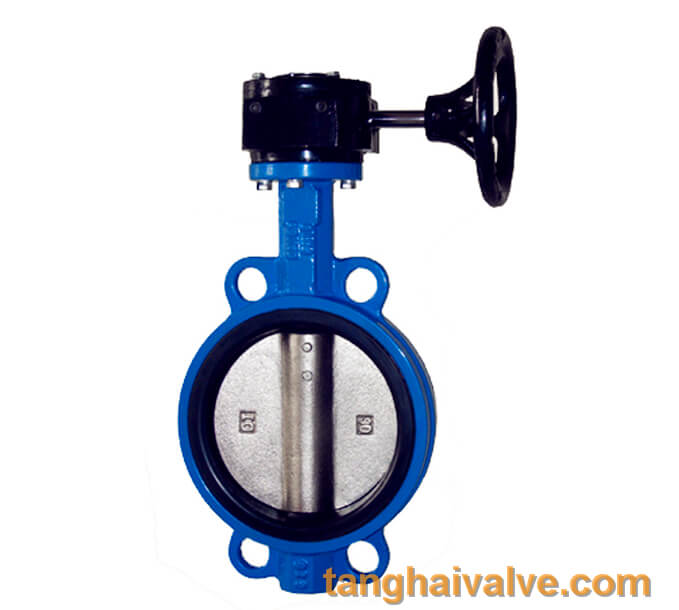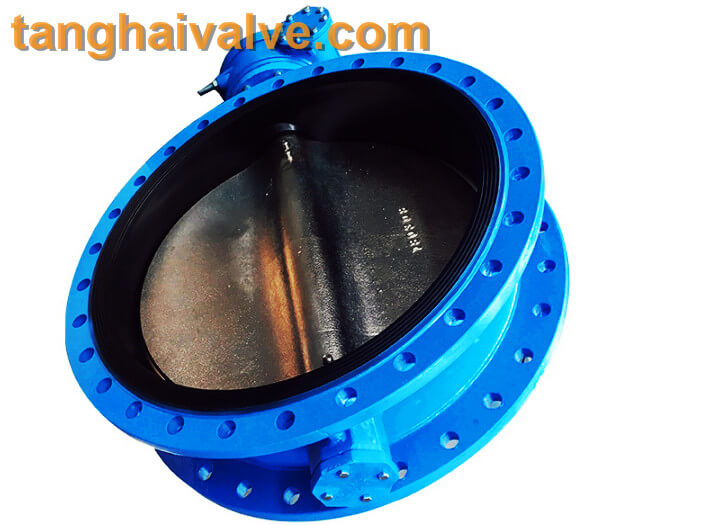Comparison of the characteristics of wafer butterfly valves and flanged butterfly valves
To find out what is the difference between the wafer butterfly valve and the flange butterfly valve, let’s take a look at the comparison of some characteristics of the wafer butterfly valve and the flange butterfly valve.

Wafer type butterfly valve with worm gear
The biggest difference is of course that the flanged butterfly valve has two more flanges, and the wafer type has two fewer flanges. Of course, the price is cheaper, and the price is about 2/3 of the flange. Flange butterfly valves are more reliable than wafer butterfly valves. Wafer butterfly valves are not as convenient as flanged butterfly valves in installation, because they need to be equipped with flanges, which can easily leak if they are not installed well.
From the perspective of specific working conditions, when selecting imported valves, use wafer-type butterfly valves as much as possible, which are light in weight and easy to replace. However, the length of the bolts of the wafer butterfly valve is longer, and the construction accuracy is higher. If the flanges on both sides are not aligned, the bolts will be subjected to greater pressure and the valve is prone to leakage. Under high temperature conditions, the bolts of the wafer butterfly valve may cause leakage after expansion, so if it is under high temperature conditions, the wafer butterfly valve is not suitable for large pipe diameters. In addition, wafer butterfly valves generally cannot be used at the end of the pipeline and downstream where it needs to be disassembled, because when the downstream flange is disassembled, the wafer valve will fall off. In this case, a short section must be made separately. For disassembly. The wafer butterfly valve has no flanges at both ends of the valve body, only a few guide bolt holes, and the valve is

Double flange butterfly valve (17)
connected with the flanges at both ends by a set of bolts/nuts. Compared with flanged butterfly valves, it is easier to disassemble. The cost of the valve is lower, but the disadvantage is that one sealing surface has a problem, and both sealing surfaces have to be disassembled. Regarding the blue butterfly valve, the above problem does not exist, and of course it has to pay a higher cost. But the cost will be higher.
The flange type butterfly valve has flanges at both ends of the valve body, which are connected with pipe flanges. The seal is relatively more reliable.
In addition to selecting the appropriate wafer butterfly valve or flange butterfly valve, attention should also be paid to the installation and maintenance of the butterfly valve. Because this is actually a place that can affect the selection of the valve outside of the specific purpose. Let’s take a look at the specific requirements below:
1. The valve disc stops at the closed position during installation.
2. Determine the opening position according to the rotation angle of the butterfly plate.
3. For the butterfly valve with bypass valve, the bypass valve should be opened before opening.
4. Ask professionals to install according to the manufacturer’s instructions, especially the heavy butterfly valve should be fixed.
5. The butterfly plate of the butterfly valve is installed in the diameter direction of the pipeline. In the cylindrical passage of the butterfly valve body, the disc-shaped butterfly plate rotates around the axis, and the rotation angle is between 0° and 90°. When rotated to 90°, the butterfly valve is fully open.
The butterfly valve is used as a flow control, the main thing is to choose the size and type of the valve when purchasing. Butterfly valves are not only widely used in general industries such as petroleum, gas, chemical, and water treatment, but also used in cooling water systems of thermal power stations.
TH Valve is a professional manufacturer of butterfly valve, gate valve, check valve, globe valve, knife gate valve, ball valve with API, JIS, DIN standard, used in Oil, Gas, Marine industry, Water supply and drainage, fire fighting, shipbuilding, water treatment and other systems, with Nominal Diameter of DN50 to DN1200, NBR/EPDM/VITON, Certificates & Approvals: DNV-GL, Lloyds, DNV, BV, API, ABS, CCS. Standards: EN 593, API609, API6D
Related news/knowledge:
Daily maintenance and precautions of ball valves
What is a wafer type butterfly valve
electric wafer butterfly valve vs electric flange butterfly valve
Wafer type double disc swing check valve introduction



 © Copyright 2020 Tianjin Tanghaidongyang Valve Co., Ltd. All Rights Reserved.
© Copyright 2020 Tianjin Tanghaidongyang Valve Co., Ltd. All Rights Reserved.